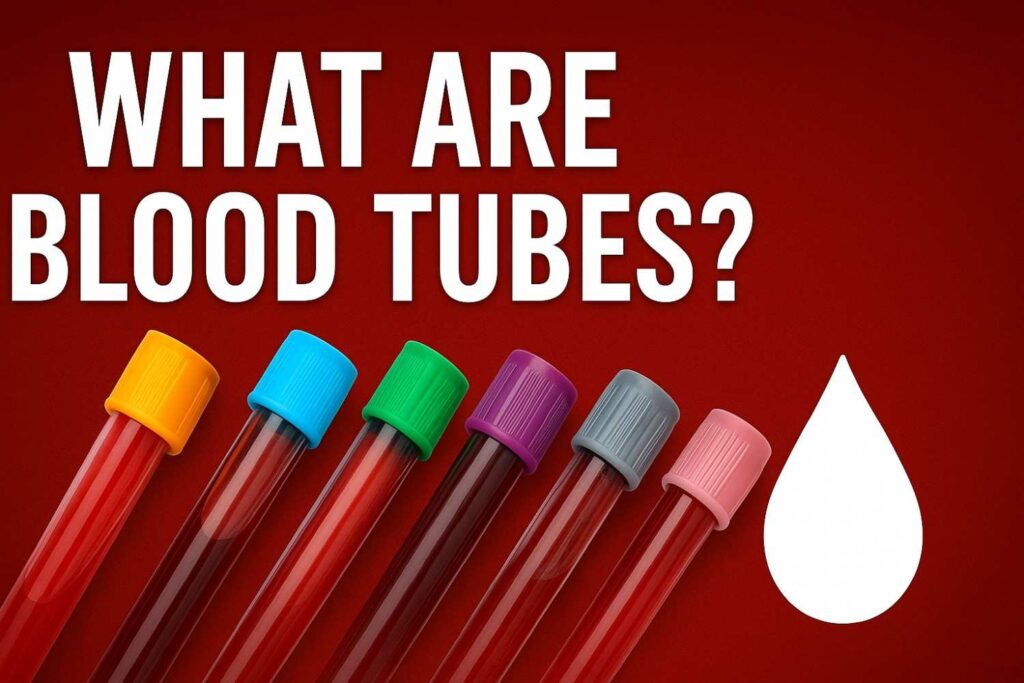
If you’ve ever had your blood drawn for testing, you may have noticed the technician using different colored tubes. Each color has a purpose — these blood tubes are not random at all. They are carefully designed to preserve the sample and ensure the lab gets accurate results.
This article will walk you through what blood tubes are, why the color codes matter, how they are used in labs, and some essential FAQs you should know.
Table of Contents
ToggleWhat Exactly Are Blood Tubes?
A blood tube, sometimes called a vacutainer, is a sterile container that collects and stores blood for laboratory testing.
Each tube contains a specific additive or gel that affects how the blood behaves once collected. These additives prevent clotting, separate serum from plasma, or stabilize certain elements in the blood so that the test remains valid.
Without these tubes and their specific formulations, even the most advanced machines would struggle to produce accurate results.
Why Do Blood Tubes Have Different Colors?
The color of the cap on a blood tube isn’t for decoration — it identifies what’s inside. Every color corresponds to a specific chemical or additive used during testing.
This color coding helps phlebotomists instantly recognize which tube to pick up for each type of test.
Here’s a quick look at what the main colors mean:
| Cap Color | Additive | Common Tests |
|---|---|---|
| Red | No additive | Hormones, liver function, general biochemistry |
| Yellow | Clot activator and gel | Immunology, serology, biochemistry |
| Light Blue | Sodium citrate | Coagulation studies like PT, APTT |
| Green | Heparin (sodium/lithium) | Plasma chemistry, electrolytes |
| Purple (Lavender) | EDTA | Complete Blood Count (CBC), HbA1c |
| Gray | Sodium fluoride + potassium oxalate | Glucose and lactate tests |
| Black | Sodium citrate (different ratio) | ESR test |
| Pink | EDTA (for blood bank use) | Cross-matching, blood grouping |
Each additive interacts with the sample in a unique way, depending on what the lab needs to measure.
How Blood Is Collected: Step-by-Step
- The patient is seated or lying comfortably.
- The technician cleans the puncture site, usually on the arm.
- A sterile needle is inserted into a vein.
- Tubes are attached one by one, allowing vacuum pressure to pull blood into them.
- Tubes with additives are gently inverted to mix the contents — never shaken.
- Each tube is labeled immediately with the patient’s details and test information.
Everything from the angle of the needle to the order in which tubes are filled affects test accuracy.
The “Order of Draw” Rule
The order of draw is one of the most important steps in phlebotomy. It prevents additives from one tube contaminating another. Here’s the standard order most labs follow:
- Blood culture bottles
- Light blue (Sodium citrate)
- Red or Yellow (Serum tubes)
- Green (Heparin)
- Lavender or Pink (EDTA)
- Gray (Fluoride/oxalate)
Even a small mix-up in this order can alter results, especially for tests like coagulation or glucose levels.
Common Additives and Their Purpose
| Additive | Purpose |
|---|---|
| EDTA | Prevents clotting by binding calcium; ideal for hematology tests. |
| Sodium Citrate | Keeps blood liquid for coagulation tests. |
| Heparin | Stops clot formation, often used in biochemistry tests. |
| Fluoride-Oxalate | Preserves glucose levels by blocking glycolysis. |
| Clot Activator | Speeds up clotting to separate serum quickly. |
How Labs Choose Which Tube to Use
The right tube is chosen based on what the test needs from the sample — plasma, serum, or whole blood.
For example:
- A CBC test requires whole blood, so an EDTA (purple) tube is used.
- A blood glucose test uses a gray tube with fluoride to prevent sugar breakdown.
- For thyroid or liver function tests, a red or yellow tube works best as serum is required.
Even the ratio between blood and additive must be perfect. Too little or too much can lead to false readings.
Storing and Handling Blood Tubes
To keep results accurate:
- Store tubes at room temperature (18°C–25°C).
- Keep them away from sunlight and moisture.
- Never use a tube past its expiry date.
- Handle filled tubes gently to avoid hemolysis (damage to blood cells).
Proper handling can make the difference between a correct diagnosis and a misleading one.
Practical Tips for Lab Staff and Students
- Always check the expiry date before using a tube.
- Stick to the correct draw order every time.
- Label the tubes immediately after filling.
- Dispose of used tubes in biohazard containers only.
- Keep records of lot numbers for traceability.
Consistency is what ensures reliability in diagnostics.
Frequently Asked Questions (FAQs)
Because every test needs a different sample state. Some tests need the blood to clot, others need it to remain fluid. Using the wrong tube can ruin the sample.
Yes. Expired tubes may lose vacuum pressure or have degraded additives, which can alter test outcomes.
They don’t shake — they invert the tube slowly to mix additives with blood. Shaking can break blood cells.
Additives from one tube can contaminate another, leading to wrong readings, especially for clotting or glucose tests.
Most modern tubes are vacuum-sealed to draw the correct amount of blood without manual effort.
Disclaimer
This article is written for educational and informational purposes only.
It should not replace medical training, laboratory protocols, or professional advice.
For specific guidance on blood collection and testing, always follow your institution’s procedures or consult a certified pathologist or laboratory professional.
Final Thoughts
Blood tubes may look simple, but each one plays a precise role in medical diagnostics. The colors, additives, and even the way they’re handled all work together to ensure doctors receive reliable results.
The next time you have a blood test, take a look at those tubes — behind every color lies the science that helps doctors make life-saving decisions.




